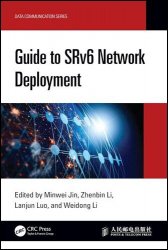Guide to SRv6 Network Deployment
- Добавил: literator
- Дата: 26-09-2024, 14:44
- Комментариев: 0
 Название: Guide to SRv6 Network Deployment
Название: Guide to SRv6 Network DeploymentАвтор: Minwei Jin, Zhenbin Li, Lanjun Luo, Weidong Li
Издательство: CRC Press
Год: 2025
Страниц: 534
Язык: английский
Формат: pdf (true)
Размер: 50.2 MB
This book shows how SRv6 can be used in real-world network deployments, providing real-world project cases from multiple carriers and enterprises. Segment Routing (SR) has matured significantly over the past decade. Its derivative, SR over IPv6 data plane (SRv6), has experienced rapid development in recent years and has gained wide acceptance among carriers. However, despite the growing interest in SRv6 deployment and the desire for detailed information, no reference material is available. This book aims to fill this gap by providing a comprehensive description of how SRv6 can be used in real network deployment scenarios. Written by participants in Huawei’s SRv6 project, this book provides an in-depth look at the project’s solution design and deployment guidelines. It also provides insights into the latest progress of SRv6 header compression standards and provides examples. This book is a valuable reference for academics and students majoring in data communications, as well as for data communications professionals and managers responsible for network planning and design, and network operation and maintenance management.
IP networks are changing. In recent years, carriers and enterprises have gradually started to upgrade their networks from IPv4 to IPv6 due to the exhaustion of IPv4 addresses. With the development of 5G, cloud, and industry digitalization, the deployment of Segment Routing over IPv6 (SRv6) is picking up speed around the world. SRv6 has become a mature technology and provides carriers and enterprises with higher network programming and end-to-end (E2E) service deployment capabilities.
As a protocol born in the Software-Defined Network (SDN) era, Segment Routing (SR) provides a flexible semi-centralized and semi-distributed architecture. With this architecture, SR reduces the number of protocols that are required. In addition, it allows network paths to be programmed more flexibly than traditional traffic engineering (TE) after network controllers are introduced. With the development and practice of technologies, SRv6 is inherently compatible with native IPv6 route forwarding and can implement interworking between different networks based on IP reachability. Therefore, SRv6 is deployed along with the IPv6-oriented upgrade of customer networks. SRv6 provides users with more network services, including In-situ Flow Information Telemetry (IFIT) and network slicing through various IPv6 extension headers.
SRv6 has been widely accepted and applied to various different service provider networks, including telecom carrier, enterprise, and Internet Service Provider (ISP) networks. During network design and deployment, many factors need to be considered due to the flexibility of SRv6 and the differences between SRv6 and traditional network features. During communication activities, many of our customers gave us the feedback that they expect a systematic book for comprehensive and detailed instruction. It is in this context that we developed this book. This book describes how SRv6 is deployed on networks through deployment instructions and detailed practice cases.
This book consists of 11 chapters, which are briefly described as follows:
• Chapter 1 briefly reviews the development history of SRv6, introduces the fundamentals and advantages of SRv6 network programming, and describes the standardization progress, industry activities, and commercial deployment of SRv6.
• Chapter 2 analyzes the impact of an increase in the SRv6 header length on the network and introduces the latest research results and interoperability test results in terms of SRv6 compression.
• Chapter 3 describes network innovation enabled by SRv6. With the development of 5G and cloud, SRv6 is ushering in a new era of IPv6 applications. Technologies — such as IPv6 network slicing, IFIT, and Application-aware IPv6 Networking (APN6) — can be deployed together with SRv6 on IPv6 networks to improve service capabilities.
...
• Chapter 10 describes the changes in SRv6 network Operations and Maintenance (O&M) and how to manage and maintain an SRv6 network with a controller, including routine maintenance, path optimization, quality measurement, and fault locating.
• Chapter 11 describes the development prospects of SRv6 networks.
Скачать Guide to SRv6 Network Deployment
Внимание
Уважаемый посетитель, Вы зашли на сайт как незарегистрированный пользователь.
Мы рекомендуем Вам зарегистрироваться либо войти на сайт под своим именем.
Уважаемый посетитель, Вы зашли на сайт как незарегистрированный пользователь.
Мы рекомендуем Вам зарегистрироваться либо войти на сайт под своим именем.
Информация
Посетители, находящиеся в группе Гости, не могут оставлять комментарии к данной публикации.
Посетители, находящиеся в группе Гости, не могут оставлять комментарии к данной публикации.
